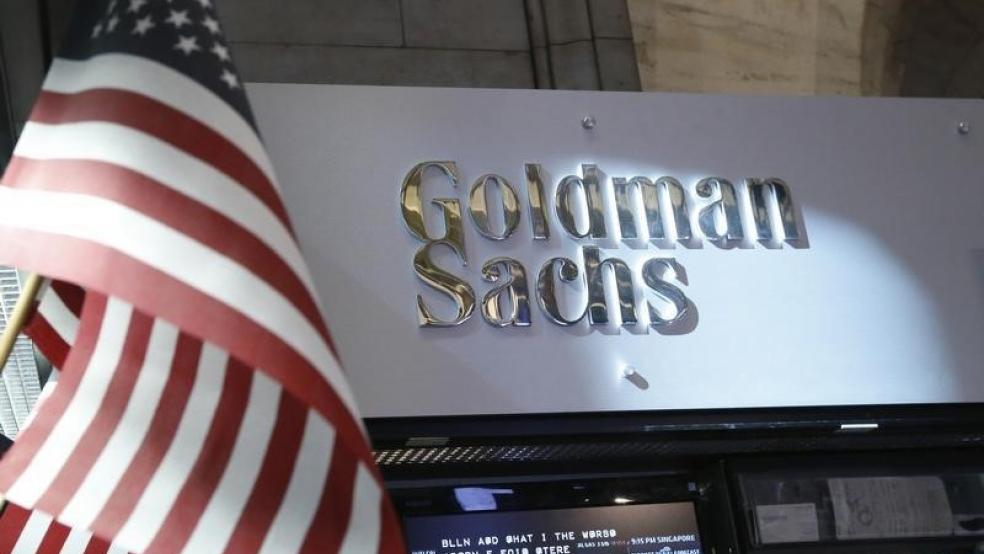Goldman Sachs is on a shopping spree. Last week, it spent $500 million to buy 12 percent of Riverstone Holdings, a private equity firm focused on energy investments. This is part of a $2 billion private equity strategy for the vampire squid. Through a couple of subsidiary funds, Goldman has already acquired stakes in private equity players Littlejohn & Co. and ArcLight Capital Partners, and Accel-KKR, a firm specializing in tech companies.
There’s only one problem with these investments: They’re supposed to be illegal under the Dodd-Frank Act. But “the law” is only as good as the men and women willing to enforce it, as Goldman Sachs has discovered to its delight. Big banks have turned one key section of Dodd-Frank into mush, such that Goldman can flaunt its defiance openly without an ounce of fear. It makes me wonder why House Republicans are working so hard to repeal Wall Street reform when regulators have shown so much willingness to repeal by neglect.
Related: Killing Banking Rules Will Invite a Whopper of a Recession
The Volcker rule, named after former Federal Reserve Chairman Paul Volcker, intended to prevent banks from trading on their own accounts, to reduce what amounts to gambling with depositor funds. One part of the rule sought to stop banks from owning or sponsoring private equity firms and hedge funds. Not only does this segregate depositor money from high-risk activities, but it limits a cheap source of cash for lightly regulated “shadow banks.” Severing the link between potential failures and the broader banking system could prevent toxic contagion from spreading. And we shouldn’t encourage predatory capitalism that hurts workers by throwing government-guaranteed deposits at it.
Bank lobbyists weakened the Volcker rule before it was finalized. Then-Senator Scott Brown, the 60th vote for Dodd-Frank in the Senate, inserted a loophole that enabled firms like Goldman Sachs to keep a “de minimis” 3 percent stake in hedge funds or private equity firms. But what Goldman announced with Riverstone equaled four times that number. How is this allowable?
Under a regulatory interpretation from the Federal Reserve, if a new investment fund is in its “seeding” phase, banks can own as much as 100 percent for a “brief period” of up to one year. But Riverstone isn’t new, having been founded in 2000. However, if the investment were structured to look like it’s initiating new funds within Riverstone, the Fed could accept the deal.
Related: Democrats Dig in, Delay Against Dodd-Frank Overhaul
At least under that interpretation, Goldman would have to scale back its investment to the 3 percent threshold after a year, right? Wrong. In their rule, the Fed officials write that they “understand that the seeding period… may take some time, for example, three years.”
The Fed has been all too happy to grant elongated timelines for the Volcker rule. Banks initially had four years from the passage of Dodd-Frank to get rid of existing investments in hedge funds and private equity firms. But the Fed delayed the divestiture for a year, then for another two years, which defied the statute, because the central bank was only permitted to delay one year at a time. Last week we learned in Goldman Sachs’ quarterly financial report that last December, the Fed allowed banks to apply for another five-year extension to liquidate the investments. “The firm received this extension for substantially all its remaining investments,” according to the filing.
Other firms received the same treatment, but Goldman holds a much larger amount of legacy assets — over $6.2 billion worth. The banks claim that untangling long-term investments would force them to undertake fire sales and harm their businesses. But this means that a law written in 2010 now doesn’t require compliance until 2022.
Related: Why Big Banks Could Still Pay a Big Price for the Housing Crisis
So Goldman Sachs doesn’t have to jettison its old private equity investments, doesn’t have to limit itself to a 3 percent stake on new investments and doesn’t have to reduce those new holdings for at least three years. You begin to wonder whether the Volcker rule exists in name only, with the dictates mere suggestions instead of directives.
Even if Goldman were misbehaving, Volcker rule enforcement has been practically non-existent. Since the 2014 implementation date, exactly one bank has been fined for non-compliance, for a grand total of $19.7 million.
Goldman has found other ways to, in the words of The Wall Street Journal, “navigate the new rules” — for example, eliminating the private equity middleman and buying up real estate assets and private corporations through its merchant banking business, using a mix of client funds and in-house money. Goldman has essentially dared regulators to stop its degradation of the rule. As then-Goldman president Gary Cohn said in 2012, “we will continue to source and pursue attractive investments on behalf of our clients.”
Related: Banks Behaving Badly: Wells Fargo, Barclays Show Little Has Changed
Cohn’s statement speaks to the near-impossibility of expecting anyone inside government to challenge Goldman; he’s now director of the White House’s National Economic Council. If the SEC wanted to look into this, it would go through former Goldman Sachs lawyer and current chair Jay Clayton. The main regulator, the Fed, has already shown its eagerness to interpret the law loosely. That’s why banks want the Fed to have sole authority on Volcker rule enforcement. And Donald Trump’s nominee to run financial supervision at the central bank, Randal Quarles, comes out of the private equity industry, and is presumably content with continued big bank investments in the space.
This gives Goldman the confidence to build a $2 billion fund for activities it’s not really supposed to be undertaking. And it’s why banks are far less interested in House Republicans’ attempt to overturn Dodd-Frank, which passed the Financial Services Committee last week, than in the regulators who will choose to ignore the law.
Just look at the legislative difficulties of the early Trump administration and you can see the folly in expecting bills to sail through Congress. But financial regulations don’t need to be canceled through legislative action. Big Finance is more than capable of whittling even a strong measure down to nothing. Plus, regulators who bend over backwards to take the side of those they regulate make a mockery of the law.
Related: Why Trump’s Attack on Dodd-Frank Is Dangerous
The result is an ineffective policy that complicates the otherwise clean political debate over regulation. Why should Democrats defend a law that’s so watered down, delayed and compromised? Why should Republicans bother to spend political capital to defeat it, rather than going through the motions and letting regulatory abandonment do the job?
It speaks to the weaknesses of half-measures and technocratic tweaks when the banking industry is the adversary. The Volcker rule was needlessly vague and complex, providing industry lobbyists the space they needed to render it irrelevant. The lesson for the future is this: To really impact Wall Street’s activities, you have to attack the structure of finance directly, not at the margins. It’s the only way to even hope to get the job done.






